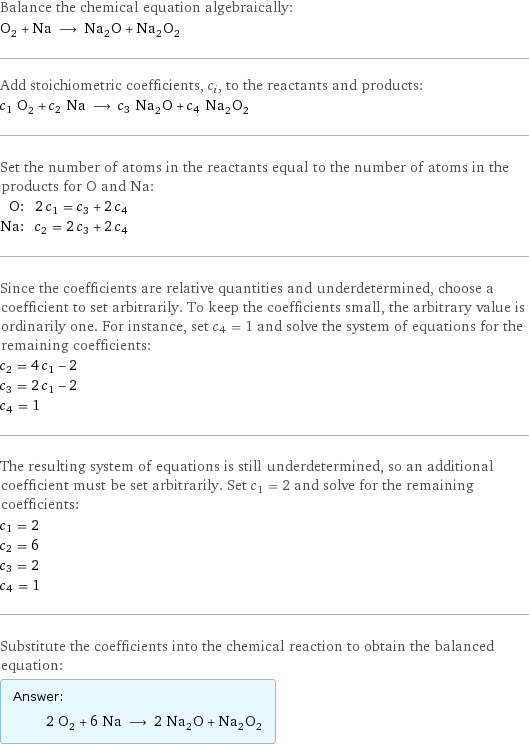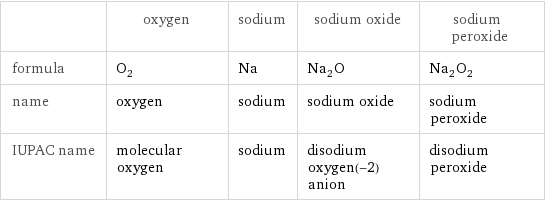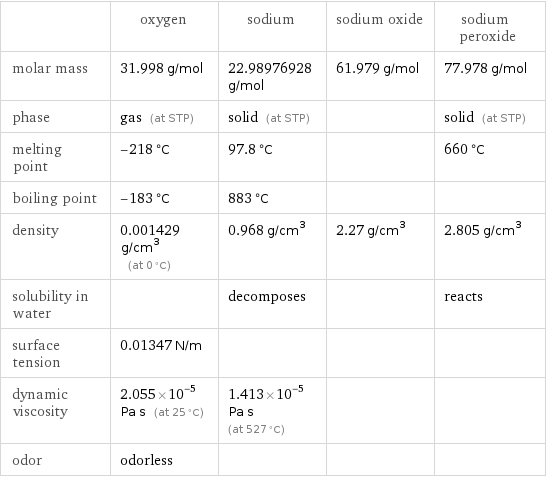Input interpretation

O_2 oxygen + Na sodium ⟶ Na_2O sodium oxide + Na_2O_2 sodium peroxide
Balanced equation

Balance the chemical equation algebraically: O_2 + Na ⟶ Na_2O + Na_2O_2 Add stoichiometric coefficients, c_i, to the reactants and products: c_1 O_2 + c_2 Na ⟶ c_3 Na_2O + c_4 Na_2O_2 Set the number of atoms in the reactants equal to the number of atoms in the products for O and Na: O: | 2 c_1 = c_3 + 2 c_4 Na: | c_2 = 2 c_3 + 2 c_4 Since the coefficients are relative quantities and underdetermined, choose a coefficient to set arbitrarily. To keep the coefficients small, the arbitrary value is ordinarily one. For instance, set c_4 = 1 and solve the system of equations for the remaining coefficients: c_2 = 4 c_1 - 2 c_3 = 2 c_1 - 2 c_4 = 1 The resulting system of equations is still underdetermined, so an additional coefficient must be set arbitrarily. Set c_1 = 2 and solve for the remaining coefficients: c_1 = 2 c_2 = 6 c_3 = 2 c_4 = 1 Substitute the coefficients into the chemical reaction to obtain the balanced equation: Answer: | | 2 O_2 + 6 Na ⟶ 2 Na_2O + Na_2O_2
Structures

+ ⟶ +
Names

oxygen + sodium ⟶ sodium oxide + sodium peroxide
Equilibrium constant
![Construct the equilibrium constant, K, expression for: O_2 + Na ⟶ Na_2O + Na_2O_2 Plan: • Balance the chemical equation. • Determine the stoichiometric numbers. • Assemble the activity expression for each chemical species. • Use the activity expressions to build the equilibrium constant expression. Write the balanced chemical equation: 2 O_2 + 6 Na ⟶ 2 Na_2O + Na_2O_2 Assign stoichiometric numbers, ν_i, using the stoichiometric coefficients, c_i, from the balanced chemical equation in the following manner: ν_i = -c_i for reactants and ν_i = c_i for products: chemical species | c_i | ν_i O_2 | 2 | -2 Na | 6 | -6 Na_2O | 2 | 2 Na_2O_2 | 1 | 1 Assemble the activity expressions accounting for the state of matter and ν_i: chemical species | c_i | ν_i | activity expression O_2 | 2 | -2 | ([O2])^(-2) Na | 6 | -6 | ([Na])^(-6) Na_2O | 2 | 2 | ([Na2O])^2 Na_2O_2 | 1 | 1 | [Na2O2] The equilibrium constant symbol in the concentration basis is: K_c Mulitply the activity expressions to arrive at the K_c expression: Answer: | | K_c = ([O2])^(-2) ([Na])^(-6) ([Na2O])^2 [Na2O2] = (([Na2O])^2 [Na2O2])/(([O2])^2 ([Na])^6)](../image_source/e861f5d11d8fcf28162ddd23dffdaaab.png)
Construct the equilibrium constant, K, expression for: O_2 + Na ⟶ Na_2O + Na_2O_2 Plan: • Balance the chemical equation. • Determine the stoichiometric numbers. • Assemble the activity expression for each chemical species. • Use the activity expressions to build the equilibrium constant expression. Write the balanced chemical equation: 2 O_2 + 6 Na ⟶ 2 Na_2O + Na_2O_2 Assign stoichiometric numbers, ν_i, using the stoichiometric coefficients, c_i, from the balanced chemical equation in the following manner: ν_i = -c_i for reactants and ν_i = c_i for products: chemical species | c_i | ν_i O_2 | 2 | -2 Na | 6 | -6 Na_2O | 2 | 2 Na_2O_2 | 1 | 1 Assemble the activity expressions accounting for the state of matter and ν_i: chemical species | c_i | ν_i | activity expression O_2 | 2 | -2 | ([O2])^(-2) Na | 6 | -6 | ([Na])^(-6) Na_2O | 2 | 2 | ([Na2O])^2 Na_2O_2 | 1 | 1 | [Na2O2] The equilibrium constant symbol in the concentration basis is: K_c Mulitply the activity expressions to arrive at the K_c expression: Answer: | | K_c = ([O2])^(-2) ([Na])^(-6) ([Na2O])^2 [Na2O2] = (([Na2O])^2 [Na2O2])/(([O2])^2 ([Na])^6)
Rate of reaction
![Construct the rate of reaction expression for: O_2 + Na ⟶ Na_2O + Na_2O_2 Plan: • Balance the chemical equation. • Determine the stoichiometric numbers. • Assemble the rate term for each chemical species. • Write the rate of reaction expression. Write the balanced chemical equation: 2 O_2 + 6 Na ⟶ 2 Na_2O + Na_2O_2 Assign stoichiometric numbers, ν_i, using the stoichiometric coefficients, c_i, from the balanced chemical equation in the following manner: ν_i = -c_i for reactants and ν_i = c_i for products: chemical species | c_i | ν_i O_2 | 2 | -2 Na | 6 | -6 Na_2O | 2 | 2 Na_2O_2 | 1 | 1 The rate term for each chemical species, B_i, is 1/ν_i(Δ[B_i])/(Δt) where [B_i] is the amount concentration and t is time: chemical species | c_i | ν_i | rate term O_2 | 2 | -2 | -1/2 (Δ[O2])/(Δt) Na | 6 | -6 | -1/6 (Δ[Na])/(Δt) Na_2O | 2 | 2 | 1/2 (Δ[Na2O])/(Δt) Na_2O_2 | 1 | 1 | (Δ[Na2O2])/(Δt) (for infinitesimal rate of change, replace Δ with d) Set the rate terms equal to each other to arrive at the rate expression: Answer: | | rate = -1/2 (Δ[O2])/(Δt) = -1/6 (Δ[Na])/(Δt) = 1/2 (Δ[Na2O])/(Δt) = (Δ[Na2O2])/(Δt) (assuming constant volume and no accumulation of intermediates or side products)](../image_source/8d1602a97b959a155f41ebe3d6506ab1.png)
Construct the rate of reaction expression for: O_2 + Na ⟶ Na_2O + Na_2O_2 Plan: • Balance the chemical equation. • Determine the stoichiometric numbers. • Assemble the rate term for each chemical species. • Write the rate of reaction expression. Write the balanced chemical equation: 2 O_2 + 6 Na ⟶ 2 Na_2O + Na_2O_2 Assign stoichiometric numbers, ν_i, using the stoichiometric coefficients, c_i, from the balanced chemical equation in the following manner: ν_i = -c_i for reactants and ν_i = c_i for products: chemical species | c_i | ν_i O_2 | 2 | -2 Na | 6 | -6 Na_2O | 2 | 2 Na_2O_2 | 1 | 1 The rate term for each chemical species, B_i, is 1/ν_i(Δ[B_i])/(Δt) where [B_i] is the amount concentration and t is time: chemical species | c_i | ν_i | rate term O_2 | 2 | -2 | -1/2 (Δ[O2])/(Δt) Na | 6 | -6 | -1/6 (Δ[Na])/(Δt) Na_2O | 2 | 2 | 1/2 (Δ[Na2O])/(Δt) Na_2O_2 | 1 | 1 | (Δ[Na2O2])/(Δt) (for infinitesimal rate of change, replace Δ with d) Set the rate terms equal to each other to arrive at the rate expression: Answer: | | rate = -1/2 (Δ[O2])/(Δt) = -1/6 (Δ[Na])/(Δt) = 1/2 (Δ[Na2O])/(Δt) = (Δ[Na2O2])/(Δt) (assuming constant volume and no accumulation of intermediates or side products)
Chemical names and formulas

| oxygen | sodium | sodium oxide | sodium peroxide formula | O_2 | Na | Na_2O | Na_2O_2 name | oxygen | sodium | sodium oxide | sodium peroxide IUPAC name | molecular oxygen | sodium | disodium oxygen(-2) anion | disodium peroxide
Substance properties

| oxygen | sodium | sodium oxide | sodium peroxide molar mass | 31.998 g/mol | 22.98976928 g/mol | 61.979 g/mol | 77.978 g/mol phase | gas (at STP) | solid (at STP) | | solid (at STP) melting point | -218 °C | 97.8 °C | | 660 °C boiling point | -183 °C | 883 °C | | density | 0.001429 g/cm^3 (at 0 °C) | 0.968 g/cm^3 | 2.27 g/cm^3 | 2.805 g/cm^3 solubility in water | | decomposes | | reacts surface tension | 0.01347 N/m | | | dynamic viscosity | 2.055×10^-5 Pa s (at 25 °C) | 1.413×10^-5 Pa s (at 527 °C) | | odor | odorless | | |
Units
